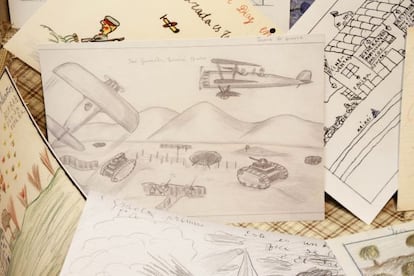“Dear Father: I want you to come soon. I’m living in the USSR”
Children's drawings from the Civil War are currently on display in Alicante

"Dear Father, I want you to come soon. I'm living in the USSR, and I really love Spain." So wrote eight-year-old Sergio Vargas in colored pencil, remembering his family in Madrid. When the Civil War broke out, hundreds of children like Sergio became victims and spectators of the conflict.
Between the fall of 1936 and the end of the war, the Republican government created various school camps on the home front, especially in Valencia, Catalonia and Murcia - and devised an evacuation plan for kids in the most dangerous zones, such as Madrid or Teruel.
In these camps, the boys and girls drew pictures to express what they were feeling. The Aifos Gallery, in the Arts department at the University of Alicante, has just opened an exhibition titled Llapis, paper, i bombes. 1936-1939 (or, Pencils, Papers and Bombs: 1936-1939.) The display consists of 100 drawings by these children, who were evacuated to various parts of Europe and looked after in encampments during the Civil War.
During their stay, the children immortalized the harrowing experiences of the war with colored-pencil drawings. The young artists ranged from seven to 14 years old, and the majority had left their parents and older siblings at home on the battlefront.
"Drawing was their therapy, their way of expressing their feelings," explains Remedios Izquierdo, one of the curators of the exhibition, whose genesis was a brief article published 10 years ago in the Ciberpaís supplement of this newspaper.
"I got dozens of drawings off the internet, and I felt like I had to locate the originals," says the passionate professor, who immediately shared her idea with several other teachers in the school: José Antonio Fernández Cabello, Ramón Galdrán, Carlos Salinas and Teresa Sanz.
It's an uncensored look at the Civil War"
"We realized the sentimental and pedagogical value of these drawings," says Fernández Cabello. "It's an uncensored look at the Civil War."
One of these drawings portrays a highly dichotomized Spain: the gentlemen and the comrades - the first group killing and the second working.
The University of Alicante has finally united these drawings in a single exhibition, drawing material from the archives of diverse institutions such as the Spanish National Library, the University of California-San Diego and Columbia University in New York.
The exhibit features drawings by children who were evacuated to Russia, and were provided by the War and Exile Archive Association and by the Spanish Center of Moscow. The display also showcases a few black-and-white photographs from photographer Agustí Centelles' archive and posters from the era, which were provided by the Salamanca Center for Historical Memory.
Italian musician Giovanni Alberto Croatto has composed a soundtrack to accompany the exhibit that recreates common schoolyard songs - performed by students from an Orihuela school - that are overlaid with voices reading fragments of text and the sound of bombs.
The first part of the display recounts three episodes from the Civil War: the bombing of Madrid (the hometown of many of the evacuees), the bombing of Port Bou (where many of the children who were evacuated to Southern France came from), and the battle of Teruel (a beacon of hope for Republicans).
The University of Alicante museum has prepared an accompanying instructional guide that offers more information about the lives of children 75 years ago.
Tu suscripción se está usando en otro dispositivo
¿Quieres añadir otro usuario a tu suscripción?
Si continúas leyendo en este dispositivo, no se podrá leer en el otro.
FlechaTu suscripción se está usando en otro dispositivo y solo puedes acceder a EL PAÍS desde un dispositivo a la vez.
Si quieres compartir tu cuenta, cambia tu suscripción a la modalidad Premium, así podrás añadir otro usuario. Cada uno accederá con su propia cuenta de email, lo que os permitirá personalizar vuestra experiencia en EL PAÍS.
¿Tienes una suscripción de empresa? Accede aquí para contratar más cuentas.
En el caso de no saber quién está usando tu cuenta, te recomendamos cambiar tu contraseña aquí.
Si decides continuar compartiendo tu cuenta, este mensaje se mostrará en tu dispositivo y en el de la otra persona que está usando tu cuenta de forma indefinida, afectando a tu experiencia de lectura. Puedes consultar aquí los términos y condiciones de la suscripción digital.
Últimas noticias
Most viewed
- Pablo Escobar’s hippos: A serious environmental problem, 40 years on
- Why we lost the habit of sleeping in two segments and how that changed our sense of time
- Charles Dubouloz, mountaineering star, retires at 36 with a farewell tour inspired by Walter Bonatti
- Reinhard Genzel, Nobel laureate in physics: ‘One-minute videos will never give you the truth’
- The Florida Keys tourist paradise is besieged by immigration agents: ‘We’ve never seen anything like this’








































